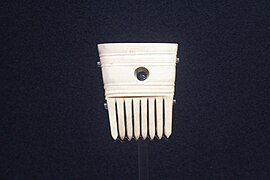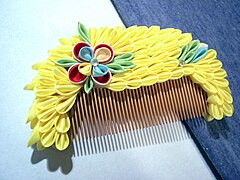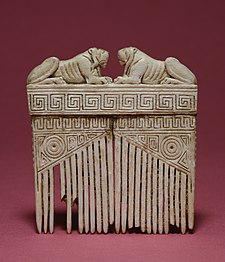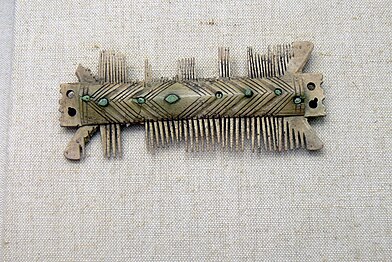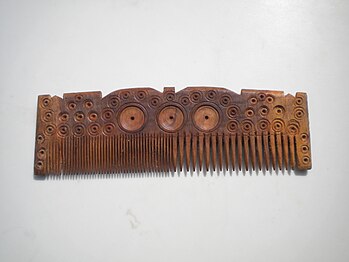Comb

A comb is a tool consisting of a shaft that holds a row of teeth for pulling through the
Weaving combs made of whalebone dating to the middle and late Iron Age have been found on archaeological digs in Orkney and Somerset.[2]
Description
Combs are made of a shaft and teeth that are placed at a perpendicular angle to the shaft. Combs can be made out of a number of materials, most commonly
Combs come in various
A hairbrush comes in both manual and electric models.[8] It is larger than a comb, and is also commonly used for shaping, styling, and cleaning hair.[9] A combination comb and hairbrush was patented in the 19th century.[10]
Uses

Combs can be used for many purposes. Historically, their main purpose was securing long hair in place, decorating the hair, matting sections of hair for dreadlocks, or keeping a kippah or skullcap in place. In Spain, a peineta is a large decorative comb used to keep a mantilla in place.[5]
In industry and craft, combs are used in separating cotton fibres from seeds and other debris (the cotton gin, a mechanized version of the comb, is one of the machines that ushered in the Industrial Revolution). A comb is used to distribute colors in paper marbling to make the swirling colour patterns in comb-marbled paper.[11]
Combs are also a tool used by police investigators to collect hair and dandruff samples that can be used in ascertaining dead or living persons' identities, as well as their state of health, toxicological profiles, and so forth.[12]
Hygiene
Sharing combs is a common cause of
Making music
Stringing a plant's leaf or a piece of paper over one side of the comb and humming with cropped lips on the opposite side dramatically increases the high-frequency harmonic content of the hum produced by the human voice box, and the resulting spread sound spectrum can be modulated by changing the resonating frequency of the oral cavity.[14] This was the inspiration for the kazoo, a membranophone.
The comb is also a
Types
Chinese combs
In China, combs are referred to by the generic term shubi (梳篦) or zhi (栉) and originated about 6000 years ago during the late Neolithic period. Chinese combs are referred as shu (梳) when referring to thick-tooth comb and bi (篦) when referred to thin-tooth comb.[17] A form of shubi produced in Changzhou is the Changzhou comb; the Palace Comb Factory, also called Changzhou combs Factory, found in the city of Changzhou started to operate since the 5th century and continues to produce handmade wooden combs up to this day.[5]: 87 Shubi were also introduced in Japan during the Nara period where they were referred by the generic name kushi.[18]
-
Shu, Shang dynasty comb
-
Qin dynasty comb
-
Western Han jade comb
-
Tang dynasty comb
-
Changzhou comb, double-edged fine-tooth comb
Japanese combs
In Japan, combs are referred to as kushi. Indigenous Japanese kushi started to be used by Japanese people about 6000 years ago in the Jōmon era. In the Nara period, Chinese combs from the Tang dynasty were introduced in Japan.[18] Another form of comb in Japan is the Satsuma comb, which started to appear around the 17th century and was produced by the samurai warriors of the Satsuma clan as a side job.[19]
-
Kushi made of tortoiseshell with lacquer, Japan, Edo or Taiso period
-
Hana kushi
Liturgical comb
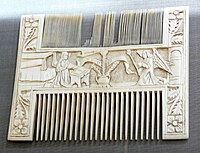
A
Nit comb

Specialized combs such as "
Afro pick
An Afro pick is a type of comb having long, thick teeth which is usually used on kinky or

The history of the Afro pick dates back at least 5,000 years, as a practical tool that may also have cultural and political meaning.[26]
Unbreakable plastic comb
An unbreakable plastic comb is a comb that, despite being made of plastic rather than (more expensive) metal, does not shatter into multiple pieces if dropped on a hard surface such as bathroom tiles, a hardwood floor, or pavement.[27] Such combs were introduced in the mid-twentieth century.[28] Today most plastic combs are unbreakable as technology has reached a point of understanding the causation of brittleness in these products.[29]
Modern artisan combs

Modern artisan combs crafted from a wide variety of new and recycled materials have become popular over recent years. Used skateboard decks, vinyl records,
Gallery
-
Ancient Egyptian comb, c. fifteenth century BC
-
Etruscan comb, c. seventh century BC
-
Scythian comb, c. 400 BC
-
Ancient Roman comb, 4th or 5th century AD
-
The world's oldest runic inscription (160 AD) on the Vimose comb, Denmark
-
A set of combs found on the 16th-century ship Mary Rose
-
Ivory sculptured comb, 16th century
-
Indian metal comb for keeping hair in place, adorned with a pair of birds. After removing the central stopper, perfume can be poured into the opening in order to moisten the teeth of the comb and the hair of the wearer.
-
APunjabiwooden comb
-
Head louse comb
-
Artisan hand-finished metal comb
-
Bamboo comb of the Kanak people
See also
References
- ^ Vaux, William Sandys Wright (1850). Nineveh and Persepolis: An Historical Sketch of Ancient Assyria and Persia, with an Account of the Recent Researches in Those Countries. A. Hall, Virtue, & Company.
- ^ Helen Chittock, “Arts and crafts in Iron Age Britain: reconsidering the aesthetic effects of weaving combs,” Oxford Journal of Archaeology, 33 (3) August 2014, pp.315-6.
- ISBN 9788763512084.
- ISBN 9780759105898.
- ^ ISBN 9780313331459. Retrieved 2016-03-07.
- ISBN 9780521838627.
- ISBN 9780415157445.
- ^ Popular Science. Bonnier Corporation. 1937. p. 39.
- ^ Cooley, Arnold James (1866). The Toilet and Cosmetic Arts in Ancient and Modern Times. R. Hardwicke. Retrieved 2016-03-07.
- ^ The Canadian Patent Office Record and Register of Copyrights and Trade Marks. Patent Office. 1895. p. 437.
- ISBN 9780812281880.
- ^ O'Sullivan, Frank Dalton; Wright, Walter Edward (1940). Practical Instruction in Police Work and Detective Science: A Course of Instruction ... Containing Lecture-lessons for Law Enforcement Officers and Others. American Police Review Publishing Company.
- ISBN 9788120791022.
- ]
- ISBN 9780521454292.
- ISBN 9780930256227. Archivedfrom the original on 2016-12-23. Retrieved 2016-03-07.
- ^ "Chinese Shubi [page 1]". en.chinaculture.org. Retrieved 2021-05-07.
- ^ a b Zhang, Linyi (2019). "Comparison of aesthetic styles of decorative combs in Japan and China". วารสารศิลปกรรมบูรพา. 20 (1): 374–384.
- ^ "Satsuma Comb – A Traditional Craft created by Samurai Warriors". Najimu-Japan. Retrieved 2022-08-19.
- ISBN 978-0195395365.
- ISBN 9780759526297.
- ^ "fine toothcomb/fine-tooth comb". WSU.edu. Archived from the original on 2010-05-28. Retrieved 2012-01-19.
- ^ Morewitz, H. (2008). "A Brief History of Lice Combs". Nuvoforheadlice.com. Archived from the original on 2008-05-10. Retrieved 2008-06-29.
- ISBN 9781610699020.
- ^ Jet. Johnson. 1972.
- ^ "Origins of the Afro Comb". cam.ac.uk.
- ISBN 9780595004294. Archivedfrom the original on 2016-12-23. Retrieved 2016-03-07.
- ^ Division, Great Britain Central Office of Information Reference (1951). Home Affairs Survey.
- ISBN 9781615030736.
- ^ "Tame your hipster beard with a comb made from what?". Archived from the original on 2016-04-14. Retrieved 2016-10-18.
External links
- Ashby, S. (2011). "An Atlas of Medieval Combs from Northern Europe". Internet Archaeology (30). doi:10.11141/ia.30.3.
- Ireland, Kay. "Cómo usar un peine navaje (How to Use Razor Combs)". eHow en Espanol (in Spanish).
- "The Origin of Combs". TheOriginOf.com. Archived from the original on 2012-09-13. Retrieved 2008-09-11.

